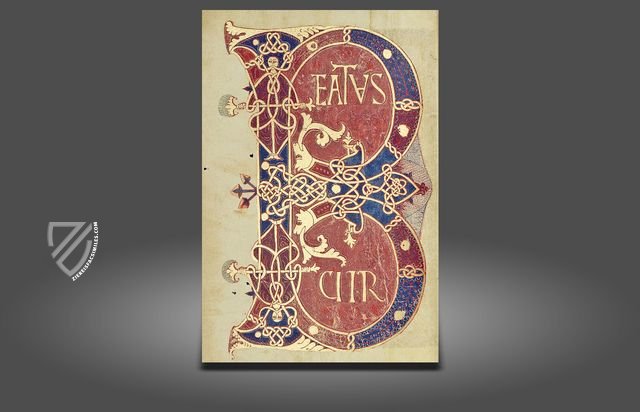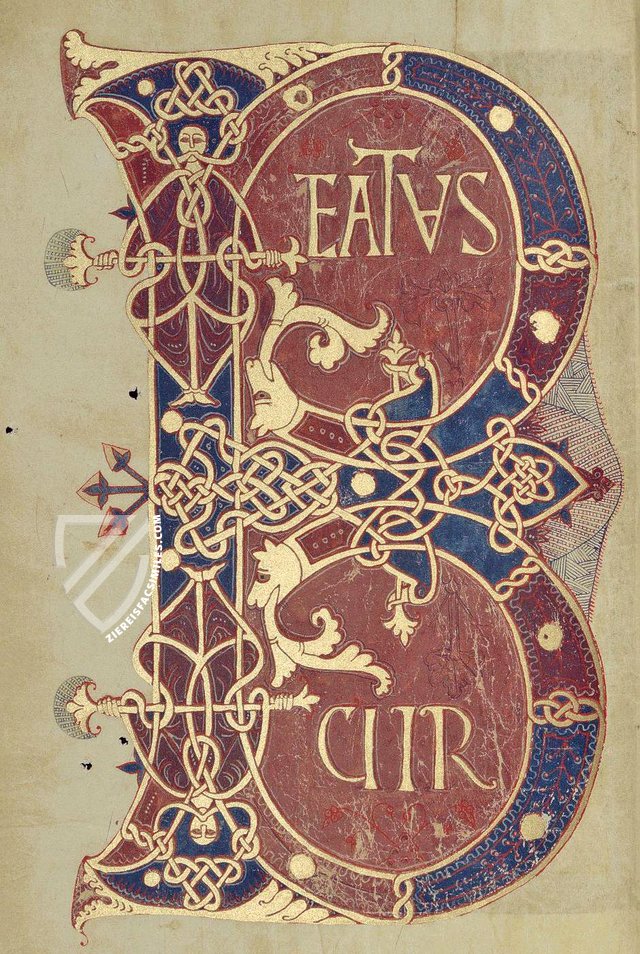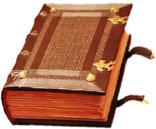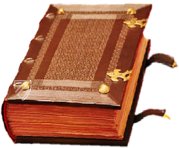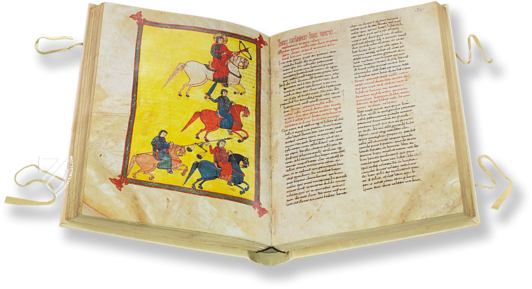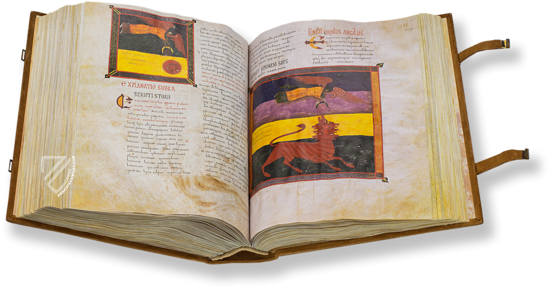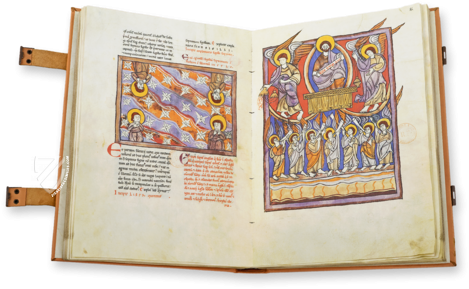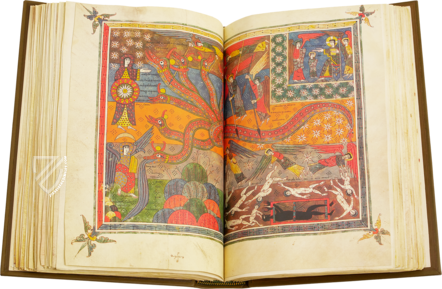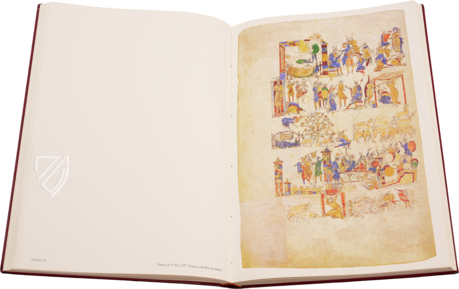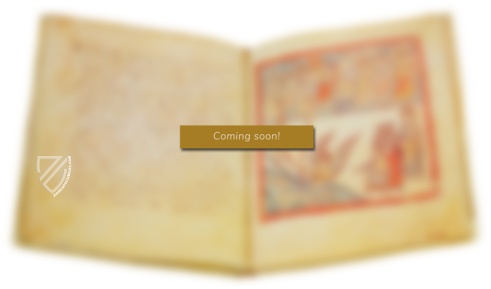Ferdinand I Book of Hours
(1,000€ - 3,000€)
The so-called Book of Hours of Ferdinand I of Castile and his wife Sancha is considered to be a primary work of 11th century Visigothic illumination. The masterpiece of Castilian illumination impresses with its purple backgrounds and gold, lavishly artistic décor of the highest quality, and its marvelously historical aura. Mozarabic influences, in addition to examples from Insular illumination, are discernable in the grandiose and exceptional initials that adorn every page of the manuscript. A testimonial to an exciting epoch in Spanish history and the great skill of Castilian artists in the mid–11th century!
Ferdinand I Book of Hours
The so-called Book of Hours of Ferdinand I of Castile and his wife Sancha is considered to be a primary work of 11th century Visigothic illumination. The masterpiece of Castilian illumination impresses with its purple backgrounds and gold, lavishly artistic décor of the highest quality, and its marvelously historical aura. Mozarabic influences, in addition to examples from Insular illumination, are discernable in the grandiose and exceptional initials that adorn every page of the manuscript. A testimonial to an exciting epoch in Spanish history and the great skill of Castilian artists in the mid–11th century!
The First King of Castile-León
Ferdinand I (1015–1065), King of Castile, was the owner or at least the patron of this magnificent prayer book. In the year 1037, Ferdinand finally became King of León, the ancestral homeland of his father. As a result the first unification of the kingdoms of Castile and León occurred during his reign, which would finally be sealed two centuries later. As the son of Sancho III of Navarra and Munia Mayor of Castile, Ferdinand inherited the united Kingdom of Castile. León came to him through military maneuvers and marriage politics, which had already been initiated by his father. In addition, he is famous for his struggle against the Moors and for the territorial expansion his dominion experienced as a result.
A Castilian Masterpiece
The co-called Book of Hours of Francis I is stored in the library of the Universidade de Santiago de Compostela. This manuscript is not exactly a book of hours in the sense of a private prayer book, but rather a psalter, a Liber canticorum et Ordo notrunalis. It originates from the year 1055 and comprises 488 pages, each of which is adorned with an impressive initial or even a large miniature. The names Pedro and Fructuoso are mentioned in the book as the copyist and miniaturist.
The Alphabet as a Fascinating Work of Art
The manuscript from the collection of Ferdinand I is undoubtedly a primary work of 11th century Visigothic illumination. The marvelously creative initials are especially amazing. In them one finds, inter alia, human and animal figures, also in connection with one another, as well as artfully ornamented elements. The rich ornamentation makes both the Mozarabic and Insular influences apparent. There are also a few full-page miniatures in the manuscript. For example, a miniature with the presentation of the manuscript to the King in the company of his wife Sancha under an artfully draped curtain and amidst a splendid decorative frame. The marvelous variety of forms competes with curious visual inventions with the initials, e.g. a man dangling from a crossbeam. All of this, with the addition of precious gold and purple backgrounds, is an indication of its royal owner, making it a grandiose masterpiece!
Codicology
- Alternative Titles
- Prayer Book of Ferdinand I
Libro de Horas de Fernando I de León
Stundenbuch Ferdinands I.
Horas de Fernando I de León
Book of Hours of Ferdinand I
Stundenbuch von Ferdinand I. - Size / Format
- 448 pages / 27.0 × 22.0 cm
- Origin
- Spain
- Date
- Mid 11th century
- Style
- Genre
- Language
- Script
- Visigothic
- Illustrations
- 7 full-page miniatures, incipits, and historiated initials as well as numerous smaller historiated initials
- Content
- Psalter, Liber canticorum et Ordo notrunalis, Liber horarum, calendar, Alcuin's “De Psalmorum usu”, Letter from Florus of Lyons to Abbot Isidore, Letter from Jerome to Paula and Eustochium, Leonese royal obituary
- Patron
- Ferdinand I (1015–1065), King of León and Emperor of Spain and his wife Queen Sancha of León (ca. 1018–67)
- Artist / School
- Petrus (scribe)
Fructosus (illuminator)
Carolingian, Ottonian, and Mozarabic influences - Previous Owners
- Monastery of San Martín Pinario
Ferdinand I Book of Hours
Incipit Page: Beatus Vir
This initial page is a masterpiece of the Spanish Romanesque style, with artistic influences ranging from the Mozarabic to the Insular. It contains the phrase Beatus vir or “Blessed is the man”, which are the opening words of the Book of Psalms in Latin. The page has survived in remarkably good condition and is worthy of its royal owner, King Ferdinand I of Castile.
Only the finest materials were used for the creation of this incipit page: red and blue were the most expensive inks, which are contrasted by the liberal use of gold leaf. Insular influences are obvious in the interlace, human faces, and animal heads that make up the “B”. Mozarabic elements are more subtle but can be found in the ornate patterns of the color fields.
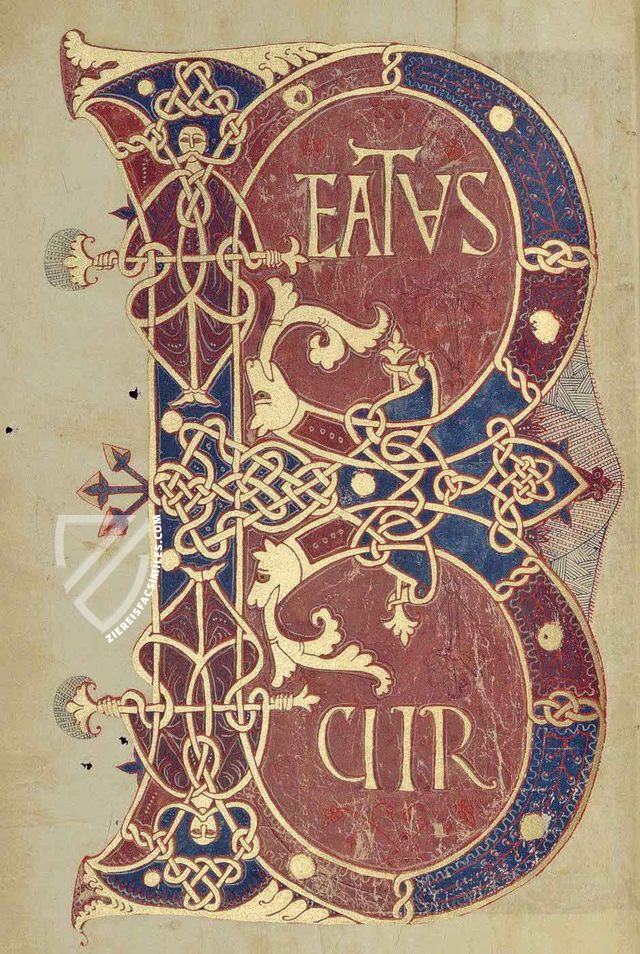
#1 Libro de Horas de Fernando I de León
Language: Spanish
(1,000€ - 3,000€)
- Treatises / Secular Books
- Apocalypses / Beatus
- Astronomy / Astrology
- Bestiaries
- Bibles / Gospels
- Chronicles / History / Law
- Geography / Maps
- Saints' Lives
- Islam / Oriental
- Judaism / Hebrew
- Single Leaf Collections
- Leonardo da Vinci
- Literature / Poetry
- Liturgical Manuscripts
- Medicine / Botany / Alchemy
- Music
- Mythology / Prophecies
- Psalters
- Other Religious Books
- Games / Hunting
- Private Devotion Books
- Other Genres
- Afghanistan
- Armenia
- Austria
- Belgium
- Belize
- Bosnia and Herzegovina
- China
- Colombia
- Costa Rica
- Croatia
- Cyprus
- Czech Republic
- Denmark
- Egypt
- El Salvador
- Ethiopia
- France
- Germany
- Greece
- Guatemala
- Honduras
- Hungary
- India
- Iran
- Iraq
- Israel
- Italy
- Japan
- Jordan
- Kazakhstan
- Kyrgyzstan
- Lebanon
- Liechtenstein
- Luxembourg
- Mexico
- Morocco
- Netherlands
- Palestine
- Panama
- Peru
- Poland
- Portugal
- Romania
- Russia
- Serbia
- Spain
- Sri Lanka
- Sweden
- Switzerland
- Syria
- Tajikistan
- Turkey
- Turkmenistan
- Ukraine
- United Kingdom
- United States
- Uzbekistan
- Vatican City
- A. Oosthoek, van Holkema & Warendorf
- Aboca Museum
- Ajuntament de Valencia
- Akademie Verlag
- Akademische Druck- u. Verlagsanstalt (ADEVA)
- Aldo Ausilio Editore - Bottega d’Erasmo
- Alecto Historical Editions
- Alkuin Verlag
- Almqvist & Wiksell
- Amilcare Pizzi
- Andreas & Andreas Verlagsbuchhandlung
- Archa 90
- Archiv Verlag
- Archivi Edizioni
- Arnold Verlag
- ARS
- Ars Magna
- ArtCodex
- AyN Ediciones
- Azimuth Editions
- Badenia Verlag
- Bärenreiter-Verlag
- Belser Verlag
- Belser Verlag / WK Wertkontor
- Benziger Verlag
- Bernardinum Wydawnictwo
- BiblioGemma
- Biblioteca Apostolica Vaticana (Vaticanstadt, Vaticanstadt)
- Bibliotheca Palatina Faksimile Verlag
- Bibliotheca Rara
- Boydell & Brewer
- Bramante Edizioni
- Bredius Genootschap
- Brepols Publishers
- British Library
- C. Weckesser
- Caixa Catalunya
- Canesi
- CAPSA, Ars Scriptoria
- Caratzas Brothers, Publishers
- Carus Verlag
- Casamassima Libri
- Centrum Cartographie Verlag GmbH
- Chavane Verlag
- Christian Brandstätter Verlag
- Circulo Cientifico
- Club Bibliófilo Versol
- Club du Livre
- CM Editores
- Collegium Graphicum
- Collezione Apocrifa Da Vinci
- Comissão Nacional para as Comemorações dos Descobrimentos Portugueses
- Coron Verlag
- Corvina
- CTHS
- D. S. Brewer
- Damon
- De Agostini/UTET
- De Nederlandsche Boekhandel
- De Schutter
- Deuschle & Stemmle
- Deutscher Verlag für Kunstwissenschaft
- DIAMM
- Droz
- E. Schreiber Graphische Kunstanstalten
- Ediciones Boreal
- Ediciones Grial
- Ediclube
- Edições Inapa
- Edilan
- Editalia
- Edition Deuschle
- Edition Georg Popp
- Edition Leipzig
- Edition Libri Illustri
- Editiones Reales Sitios S. L.
- Éditions de l'Oiseau Lyre
- Editions Medicina Rara
- Editorial Casariego
- Editorial Mintzoa
- Editrice Antenore
- Editrice Velar
- Edizioni Edison
- Egeria, S.L.
- Eikon Editores
- Electa
- Emery Walker Limited
- Enciclopèdia Catalana
- Eos-Verlag
- Ephesus Publishing
- Ernst Battenberg
- Eugrammia Press
- Extraordinary Editions
- Fackelverlag
- Facsimila Art & Edition
- Facsimile Editions Ltd.
- Facsimilia Art & Edition Ebert KG
- Faksimile Verlag
- Feuermann Verlag
- Folger Shakespeare Library
- Franco Cosimo Panini Editore
- Friedrich Wittig Verlag
- Fundación Hullera Vasco-Leonesa
- G. Braziller
- Gabriele Mazzotta Editore
- Gebr. Mann Verlag
- Gesellschaft für graphische Industrie
- Getty Research Institute
- Giovanni Domenico de Rossi
- Giunti Editore
- Graffiti
- Grafica European Center of Fine Arts
- Guido Pressler
- Guillermo Blazquez
- Gustav Kiepenheuer
- H. N. Abrams
- Harrassowitz
- Harvard University Press
- Helikon
- Hendrickson Publishers
- Henning Oppermann
- Herder Verlag
- Hes & De Graaf Publishers
- Hoepli
- Holbein-Verlag
- Houghton Library
- Hugo Schmidt Verlag
- Idion Verlag
- Il Bulino, edizioni d'arte
- ILte
- Imago
- Insel Verlag
- Insel-Verlag Anton Kippenberger
- Instituto de Estudios Altoaragoneses
- Instituto Nacional de Antropología e Historia
- Introligatornia Budnik Jerzy
- Istituto dell'Enciclopedia Italiana - Treccani
- Istituto Ellenico di Studi Bizantini e Postbizantini
- Istituto Geografico De Agostini
- Istituto Poligrafico e Zecca dello Stato
- Italarte Art Establishments
- Jan Thorbecke Verlag
- Johnson Reprint Corporation
- Josef Stocker
- Josef Stocker-Schmid
- Jugoslavija
- Karl W. Hiersemann
- Kasper Straube
- Kaydeda Ediciones
- Kindler Verlag / Coron Verlag
- Kodansha International Ltd.
- Konrad Kölbl Verlag
- Kurt Wolff Verlag
- La Liberia dello Stato
- La Linea Editrice
- La Meta Editore
- Lambert Schneider
- Landeskreditbank Baden-Württemberg
- Leo S. Olschki
- Les Incunables
- Liber Artis
- Library of Congress
- Libreria Musicale Italiana
- Lichtdruck
- Lito Immagine Editore
- Lumen Artis
- Lund Humphries
- M. Moleiro Editor
- Maison des Sciences de l'homme et de la société de Poitiers
- Manuscriptum
- Martinus Nijhoff
- Maruzen-Yushodo Co. Ltd.
- MASA
- Massada Publishers
- McGraw-Hill
- Metropolitan Museum of Art
- Militos
- Millennium Liber
- Müller & Schindler
- Nahar - Stavit
- Nahar and Steimatzky
- National Library of Wales
- Neri Pozza
- Nova Charta
- Oceanum Verlag
- Odeon
- Orbis Mediaevalis
- Orbis Pictus
- Österreichische Staatsdruckerei
- Oxford University Press
- Pageant Books
- Parzellers Buchverlag
- Patrimonio Ediciones
- Pattloch Verlag
- PIAF
- Pieper Verlag
- Plon-Nourrit et cie
- Poligrafiche Bolis
- Presses Universitaires de Strasbourg
- Prestel Verlag
- Princeton University Press
- Prisma Verlag
- Priuli & Verlucca, editori
- Pro Sport Verlag
- Propyläen Verlag
- Pytheas Books
- Quaternio Verlag Luzern
- Reales Sitios
- Recht-Verlag
- Reichert Verlag
- Reichsdruckerei
- Reprint Verlag
- Riehn & Reusch
- Roberto Vattori Editore
- Rosenkilde and Bagger
- Roxburghe Club
- Salerno Editrice
- Saltellus Press
- Sandoz
- Sarajevo Svjetlost
- Schöck ArtPrint Kft.
- Schulsinger Brothers
- Scolar Press
- Scrinium
- Scripta Maneant
- Scriptorium
- Shazar
- Siloé, arte y bibliofilia
- SISMEL - Edizioni del Galluzzo
- Sociedad Mexicana de Antropología
- Société des Bibliophiles & Iconophiles de Belgique
- Soncin Publishing
- Sorli Ediciones
- Stainer and Bell
- Studer
- Styria Verlag
- Sumptibus Pragopress
- Szegedi Tudomànyegyetem
- Taberna Libraria
- Tarshish Books
- Taschen
- Tempus Libri
- Testimonio Compañía Editorial
- Thames and Hudson
- The Clear Vue Publishing Partnership Limited
- The Facsimile Codex
- The Folio Society
- The Marquess of Normanby
- The Richard III and Yorkist History Trust
- Tip.Le.Co
- TouchArt
- TREC Publishing House
- TRI Publishing Co.
- Trident Editore
- Tuliba Collection
- Typis Regiae Officinae Polygraphicae
- Union Verlag Berlin
- Universidad de Granada
- University of California Press
- University of Chicago Press
- Urs Graf
- Vallecchi
- Van Wijnen
- VCH, Acta Humaniora
- VDI Verlag
- VEB Deutscher Verlag für Musik
- Verlag Anton Pustet / Andreas Verlag
- Verlag Bibliophile Drucke Josef Stocker
- Verlag der Münchner Drucke
- Verlag für Regionalgeschichte
- Verlag Styria
- Vicent Garcia Editores
- W. Turnowski Ltd.
- W. Turnowsky
- Waanders Printers
- Wiener Mechitharisten-Congregation (Wien, Österreich)
- Wissenschaftliche Buchgesellschaft
- Wissenschaftliche Verlagsgesellschaft
- Wydawnictwo Dolnoslaskie
- Xuntanza Editorial
- Zakład Narodowy
- Zollikofer AG

